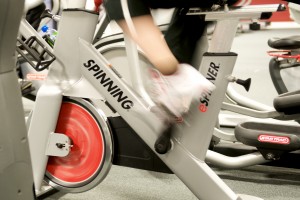 Hi gang!
Hi gang!
Good work to everyone who tackled those high intensity (or Tabata) intervals this morning.
As promised, here’s a link to a great article from Active.com that talks about the benefits of high intensity training. Named for Japanese researcher Izumi Tabata, the four-minute protocol (composed of eight reps, with 20 seconds at your lung-burning max followed by just 10 seconds of rest before your next rep) may do more to boost your performance than an hour riding at 70% of your max.
Don’t believe it? Read how Tabata tested it out, subjecting one group of elite athletes to the four-minute Tabata protocol five times a week over the course of six weeks. A second group rode at 70% of their max for an hour, five days a week for six weeks.
Who’d reap the greatest gains–the “Tabata protocol” group, who worked out for a total of 20 minutes a week, or the second group, who worked out for a total of five hours a week?
The group following the Tabata protocol improved their VO2 max by 14%, and their anaerobic capacity–or ability to perform at the highest intensities–improved by 28%. The second group didn’t show any improvement in their VO2 max or anaerobic capacity. This New York Times article describes a similar test that shows parallel endurance gains between the two test groups as well.
The Tabata intervals we perform in class are modified, with more work before (and after for the 60 minute folks) than Tabata permitted in his training, but the benefits are similar as long as your really are pushing yourself during the hardest parts of the Tabata protocol. And despite his test, I wouldn’t recommend such high-intensity work more than 2 times a week, which can lead to overtraining and injury. To mix it up, you can also do them running, swimming, on a rowing machine–basically, any cardiovascular sport. Be sure to get in a good warmup and give yourself a down day after to allow for proper muscle recovery.
****
In the last post I mentioned the Ironman World Championships, that annual competition featuring the best of the best in an event that includes a 2.4 mile swim, 112 mile bike ride, and 26.2 mile run–all of which must be completed in under 17 hours.
Among the inspiring stories this year is that of the amazing 77 year-old Harriet Anderson, who came in just under the 17-hour cutoff with seconds to spare (see the emotional finish here and an interview with her here). She raced her first Ironman when she was 53 years old and has since raced Kona over 20 times. Among her incredible achievements: in 2009, she was bumped by another cyclist 80 miles into the bike leg, fell, and broke her clavicle. Undeterred, she got up, finished the remaining 32 miles of the bike course, and walked the marathon with her arm taped to her side to finish seven minutes before the cutoff.
If that doesn’t amaze you, get this: three men over the age of 80 also finished the Kona Ironman this year. The oldest was 82 year-old Lew Hollander, who crossed the finish line about 14 minutes before Anderson.
So if you ever thought you couldn’t do a marathon or triathlon, think of Harriet and Lew and get out there!
